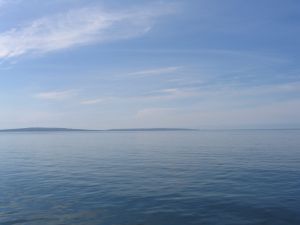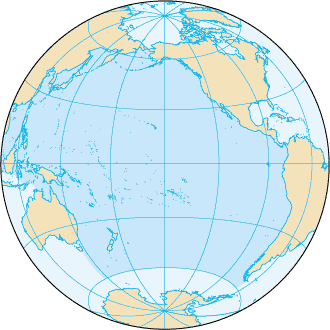Ocean exploration: Difference between revisions
Image available on commons with different name |
|||
| Line 50: | Line 50: | ||
==External links== |
==External links== |
||
| ⚫ | |||
| ⚫ | |||
* [http://www.oceanexplorer.noaa.gov Ocean Explorer] - Public outreach site for explorations sponsored by the Office of Ocean Exploration. |
|||
[[Category:Exploration]] |
|||
| ⚫ | |||
* [http://oceanexplorer.noaa.gov/gallery/gallery.html NOAA, Ocean Explorer Gallery] - A rich collection of images, video, audio and [http://oceanexplorer.noaa.gov/explorations/podcast/06oceanexplorer_podcast.xml podcast]. |
|||
* [http://www.explore.noaa.gov NOAA's Office of Ocean Exploration] |
|||
| ⚫ | |||
Revision as of 17:39, 9 March 2007

Ocean exploration is a part of oceanography describing more generally the exploration of ocean surfaces. It is also the period when people explored the ocean boundaries. Notable explorers include: the Greeks, the Egyptians, the Polynesians, the Phoenicians, Phytheas, Herodotus, the Vikings, Vasco da Gama, Ferdinand Magellan, and Christopher Columbus. Travel on the surface of the ocean through the use of boats dates back to prehistoric times, but only in modern times has extensive underwater exploration become possible. Scientific investigations began with such early scientists as James Cook, Charles Darwin and Edmund Halley. Ocean exploration itself coincided with the developments in shipbuilding, diving, navigation, depth measurement, exploration and cartography.
Timeline of ocean exploration
Early exploration
- 4500 B.C. Around this time, coastal cultures like those in Greece and China began diving into the sea as a source of food gathering, commerce, and possibly even warfare.
- 4000 Egyptians developed sailing vessels, which were probably used only in the eastern Mediterranean near the mouth of the Nile River.
- 4000 B.C. - 1000 A.D. Polynesian colonization of South Pacific Islands.
- 1800 Basic measuring of the depths is done in Egypt.
- 600 Phoenicians developed sea routes around the entire Mediterranean and into the Red Sea and the Indian Ocean. Going around Africa they reached England by sailing along the western European coast. Although they understood celestial navigation, they probably stayed within sight of land whenever possible.
- 500-200 Greeks developed trade routes in the Mediterranean using the length of the day (corrected for the time of the year) to estimate latitude.
- 450 Herodotus publishes a map of the Mediterranean region.
- 325 Pytheas, a Greek astronomer and geographer, sailed north out of the Mediterranean, reaching England and possibly even Iceland and Norway. He also developed the use of sightings on the North Star to determine latitude.
- 200 Eratosthenes determines fairly accurately the circumference of the Earth using angles of shadows in Syene and Alexandria.
- 150 B.C. Ptolemy produces a map of the Roman world, including lines of latitude and longitude, the continents of Asia, Europe, and Africa and the surrounding oceans.
- 900 A.D. -1430 A.D. Vikings explore and colonize Iceland, Greenland, Newfoundland.
- 1405-1433 Chinese send seven voyages to extend Chinese influence and impress their neighbor states. These expensive voyages are ended after a short time. See Zheng He (1371 - 1433).
- 1410 Ptolemy's map of the oceans is published once more after European crusades capture Roman libraries from Arab peoples.
From Age of Exploration to present
- 1492-1504 Christopher Columbus reaches America looking for a searoute to the Indies; discovering various lands and islands and establishing a colony on Hispaniola

- 1498 Vasco da Gama sails around Africa from Portugal reaching India and establishing trade routes
- 1519-1522 Ferdinand Magellan's ships circumnavigate the world.
- 1620 Dutch physician Cornelis Drebbel builds the world's first submarine and makes several trips in the Thames River near London at a depth of about 12 or 15 feet.
- 1698-1700 Edmund Halley made probably the first primarily scientific voyage to study the variation of the magnetic compass, sailing as far as 52 deg S. in the Atlantic Ocean. On a previous expedition to St. Helena, he made an important contribution to knowledge of the trade winds.
- 1768-1780 A.D. James Cook explores the southern parts of the oceans looking for the southern continent. He was the first to use a chronometer to determine longitude.
- 1785 A.D. Benjamin Franklin writes Sundry Marine Observations on improvements to ships and the Gulf Stream.
- 1831-1836 A.D. Charles Darwin sails on the Beagle, exploring the Galapagos and many other areas. It is this work which led him to develop the concept of natural selection and evolution.
- 1860 A.D. First chart of the Gulf Stream published by the U.S. Coast Survey.
- 1872-1876 A.D. The H.M.S. Challenger travels around the world on a scientific mission; taking sediment samples, water samples, soundings, and collecting many biological specimens.
- 1960 Bathyscaphe Trieste dives to what was believed to be the deepest point in the Mariana Trench. A depth of 10,915 meters was observed.
See also
- Ocean
- Oceanography
- Exploration
- Office of Ocean Exploration
- oceanexplorer - Public outreach site for explorations sponsored by the Office of Ocean Exploration.
- List of explorers
- List of maritime explorers
Sources
- SeaSky.org - Ocean Exploration Timeline with Credits & Sources
- NOAA - Sounding Pole to Sea Beam
- History of Ocean Exploration
- USC Earth Sciences, History of Oceanography
- skb's virtual cave - Notable oceanographic expeditions
External links
- Ocean Explorer - Public outreach site for explorations sponsored by the Office of Ocean Exploration.
- NOAA, Ocean Explorer History
- NOAA, Ocean Explorer Gallery - A rich collection of images, video, audio and podcast.
- NOAA's Office of Ocean Exploration
